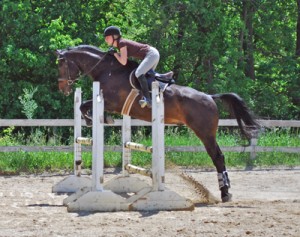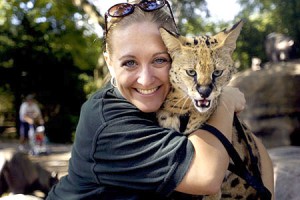The video I chose depicts a group of children at Yellowstone National Park approaching far too close to a wild bison bull with the encouragement of an adult filming the events (hereafter referred to as “Moron”), and then running for their lives when the bison – entirely predictably – charges them. This human-animal interaction illustrates the dangers of substituting voyeuristic thrill for respect for an animal.
The very first thing we hear in the video is Moron assuring the children that “he’s friendly” (B Loy). Rather than shepherding the children away from the beast that has greater strength and weight than all of them combined, Moron just stands back and films the children as they approach the bison while repeatedly exclaiming “oh my gosh” (B Loy).
As the children approach, the bison turns to face them and begins shaking its head and hind quarters about while snorting loudly: classic warning signs that it is preparing to charge. Moron even notices these “gestures,” (B Loy), although he doesn’t take any action to mitigate the considerable danger facing the children; whether this is because he didn’t realize what the gestures meant or because he was simply too empty-headed to act is unclear but given what we’ve seen of him so far, either is possible. The bison then moves to block the path it saw the children taking; because it stands its ground as the humans approach and even moves to block their path, this is clearly territorial behavior and not self-preservation instincts.
Which is bad.
As the children continue advancing, the bison’s warning gestures become more pronounced and it lowers its head – this bull is going to charge whatever draws its attention next. The two children who had managed to get past the bison are saved from almost certain death by a man who quickly hops onto the wooden footpath on the other side of the bison, the sudden motion causing it to charge. The main group of tourists flees away from the bison’s territory, but one child breaks from the group and runs parallel to the border; the animal singles this child out and pursues him, quickly closing the distance until the child turns and sprints away from the bison’s territory with less than a yard between him and the animal, at which point the bison, satisfied that it has made its point, abandons the chase (B Loy).
It is by sheer luck that nobody was killed in this incident; it’s hardly uncommon to hear about tourists gored or trampled by bison, almost universally killing the tourist. The worst part about this kind of thing is that it’s a 100% completely avoidable situation; even a modicum of common sense would have defused the situation before it escalated to the point that it did. It was by sheer luck that nobody was killed, and if it were to happen again fatalities would be almost guaranteed. It’s truly infuriating that nobody had that little bit of common sense not to approach Nature’s Rage-Filled Battering Ram.
Well, we’re calling the camera guy Moron for a reason.
Since I grew up on a farm that counted several heads of bison among its livestock (the bison were there before we were), I’m more familiar with the temperament and physical capabilities of bison than your average person idiot dad on vacation. This is why I find it simply infuriating seeing things like this charge happen. Not only does this sort of behavior jeopardize the safety of the tourists but it also epitomizes the marginalization of both the animal itself as it is reduced to a check box on the family’s vacation summary as well as its “wild-ness” as the people in the video treat it like it is a tourist attraction there solely for their amusement.
Bison are not animals to be trifled with; they can weigh to 2,000 pounds (read: a lot bigger than a person), run at up to 30 miles per hour (read: a lot faster than a person), jump up to six feet vertically (read: a lot higher than a person), and their heads sport two long, sharp horns sprouting from a bone plate in the skull that they can use to smash through a reinforced fence (read: a bison will ruin your day). Furthermore, bison are typically ill-tempered and remarkably unintelligent animals with highly aggressive and territorial dispositions, and will not hesitate to use the aforementioned physical abilities to run down and kill anything that threatens it or intrudes on their turf. As seen in the video, that includes tourists small children with questionable adult supervision. Long story short, despite being herbivores a bison can and will mess you up if you don’t treat it with caution and respect.
The group’s close approach to the bison also encroaches on its “wild-ness” as an animal and reduces it to a sideshow stop on Yuppie Dad’s Great Yellowstone Vacation Plan (patent pending). The father displays several behaviors that Malamud condemns, such as engaging in the voyeuristic thrill of watching the bison from a, at least in theory, superior vantage point of greater power (Malamud 221). While he (thankfully) doesn’t take it as far as the physical self-stimulation Nimier witnessed (qtd. in Malamud 220), Moron does take part in the all-too-common metaphorically masturbatory exercise of wrapping oneself in warm, fuzzy feelings of superiority while sipping on a hot mug of smugness and looking at the “inferior” animals of the wild. In the eyes of the tourists in the video, the bison was not a living, breathing creature but a tourism draw like Old Faithful (note: at no point has a geyser ever tried to violently kill somebody).
By reducing the bison to nothing more than a spectacle to provide fleeting amusement on vacation, the animal that was once revered as a sacred creature by the Plains Indians is marginalized until it is nothing more than a silhouette on the souvenir T-shirt your 15-year old son wears to let all his friends know about his awesome summer vacation. The bison has been marginalized to something that is only good to look at for a few minutes by the side of a road; the animal that once owned the Great Plains has been reduced to Yellowstone National Park’s Bison™, merely a mascot for a tract of land in Wyoming and Montana – or for a certain clearly inferior liberal arts college that shall remain nameless (looking at you, Chris). In the popular opinion, bison are simply objects for humans to look at in mild-to-moderate wonder; few people particularly care if the bison is looking back. Berger identified this imbalance in Why Look at Animals?: “animals are always the observed. The fact that they can observe us has lost all significance” (Berger 16). Humans are too wrapped up in looking at the bison from the windows of their Winnebagos to bother wondering if the bison is looking back, and what it might think of them.
By forgetting that bison are more than source material for screen-printed images on T-shirts, they marginalize the animal until they also forget the sheer strength and lethality it carries. This marginalization is the result of the reduction of the bison to a mascot or a tourist attraction, and stems from Man’s tendency to look down on animals who do not resemble himself. However, the human perception of the bison, no matter how erroneous, cannot change simple facts such as this:
Those kids are damn lucky.
Works Cited:
B Loy. “Angry bison charges small child at Yellowstone in scary video.” Online video clip. YouTube. YouTube, 5 Sep. 2012. Web. 9 Nov. 2014.
Berger, John. Why Look at Animals?. New York: Vintage International. 1977. Print.
Malamud, Randy. “Zoo Spectatorship.” The Animals Reader. Ed. Linda Kalof and Amy Fitzgerald. New York: Oxford Press. Print.




Recent Comments